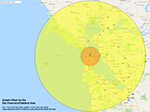 Media
Media  Blog
Blog  Trading Hours
Trading Hours  4 A.M. Last Call Research Update: "Splash Effect" Means One City's Party Is Another City's Pain
4 A.M. Last Call Research Update: "Splash Effect" Means One City's Party Is Another City's Pain4 A.M. Last Call Research Update: "Splash Effect" Means One City's Party Is Another City's Pain
Six cities' plans to paint the town red will splash blood across the whole California map.
 Despite outright rejection in last year's legislative cycle, the deep pockets of big nightclub promotion companies have persuaded the California legislature to revisit 4 a.m. last calls. The current version of the bill, still written by Scott Wiener but now labeled SB 905, only permits six cities to extend bar service hours. Those cities are San Francisco, Oakland, Sacramento, West Hollywood, Long Beach, and the City of Los Angeles.
Despite outright rejection in last year's legislative cycle, the deep pockets of big nightclub promotion companies have persuaded the California legislature to revisit 4 a.m. last calls. The current version of the bill, still written by Scott Wiener but now labeled SB 905, only permits six cities to extend bar service hours. Those cities are San Francisco, Oakland, Sacramento, West Hollywood, Long Beach, and the City of Los Angeles.
Despite the tweaks to this bill, the problems plaguing it remain obvious. Sensible last call policies are valuable policies that reduce harm without criminalizing drinking. A study on Norway during a period of patchwork last call hours shows that extending them increased assaults by 17% per additional hour. In Sydney, Australia, efforts to deal with runaway chaos from overconsumption inspired a 2-hour reduction in bar hours that reduced violence by 22% to 45%, depending on the area. Other studies on drunk driving shows that 51% more drivers got in alcohol related crashes when leaving bars with extended last calls.
More simply, keeping a bar open later means the people there will have drunk more. Far from being under debate, more drinking underlies the ostensible economic benefits accruing the handful of massive nightclubs that are sponsoring this bill. What these operators, and their reckless proxy, Sen. Wiener, are trying to hide is how easily they will avoid any of the consequences. Instead, these consequences will be borne by the tens of millions of Californians outside these newfound "party zones," as drunk drivers pour out of the city center and into quiet outlying communities. The results will be disruptive and expensive at best, lethal at worst.
In California, fatal alcohol-related crashes an ongoing crisis. According to the California Office of Traffic Safety, fully 20% more people died in alcohol-related crashes in 2016 than 2014. At the rate fatal crashes are increasing, the death toll will double between 2016 and 2024. This spike persists despite efforts to promote designated drivers, despite the claims of ride-sharing services… and despite the vacant platitudes of SB 905 supporters who want to profit and while hoping someone else deals with the aftermath.
By definition, DUIs do not occur at the place where the driver got drunk. Ventura County alone out of all California counties tracks the behaviors of drunk drivers going through its DUI diversion programs. They found that drivers had traveled an average of 7 miles before getting arrested, with a maximum of 150 miles. Around 15% of young adults were arrested returning from either Hollywood or Santa Barbara-both at least 30 miles from the Ventura County border.
With that in mind, Alcohol Justice assembled the Splash Maps for SB 905. These maps show 7-mile and 40-mile "splash zones" where the drunk driving damage will occur. In addition, we compiled lists of cities within the splash zones. (If you feel your community was not included in the list and should be, please let us know.)
LONG BEACH 
splash zone MAP
splash zone city LIST
LOS ANGELES & WEST HOLLYWOOD 
splash zone MAP
splash zone city LIST
SACRAMENTO 
splash zone MAP
splash zone city LIST
SAN FRANCISCO & OAKLAND 
splash zone MAP
splash zone city LIST
READ MORE about how Sen. Wiener exploits the deaths young Californians to pass a bill endangering many more.
READ MORE about how late last calls will hurt California.
TAKE ACTION to stop SB 905 and choose California lives over nightlife lobbies.
Help us hold Big Alcohol accountable for the harm its products cause.
| GET ACTION ALERTS AND eNEWS |
STAY CONNECTED    |
CONTACT US 24 Belvedere St. San Rafael, CA 94901 415-456-5692 |
SUPPORT US Terms of Service & Privacy Policy |

